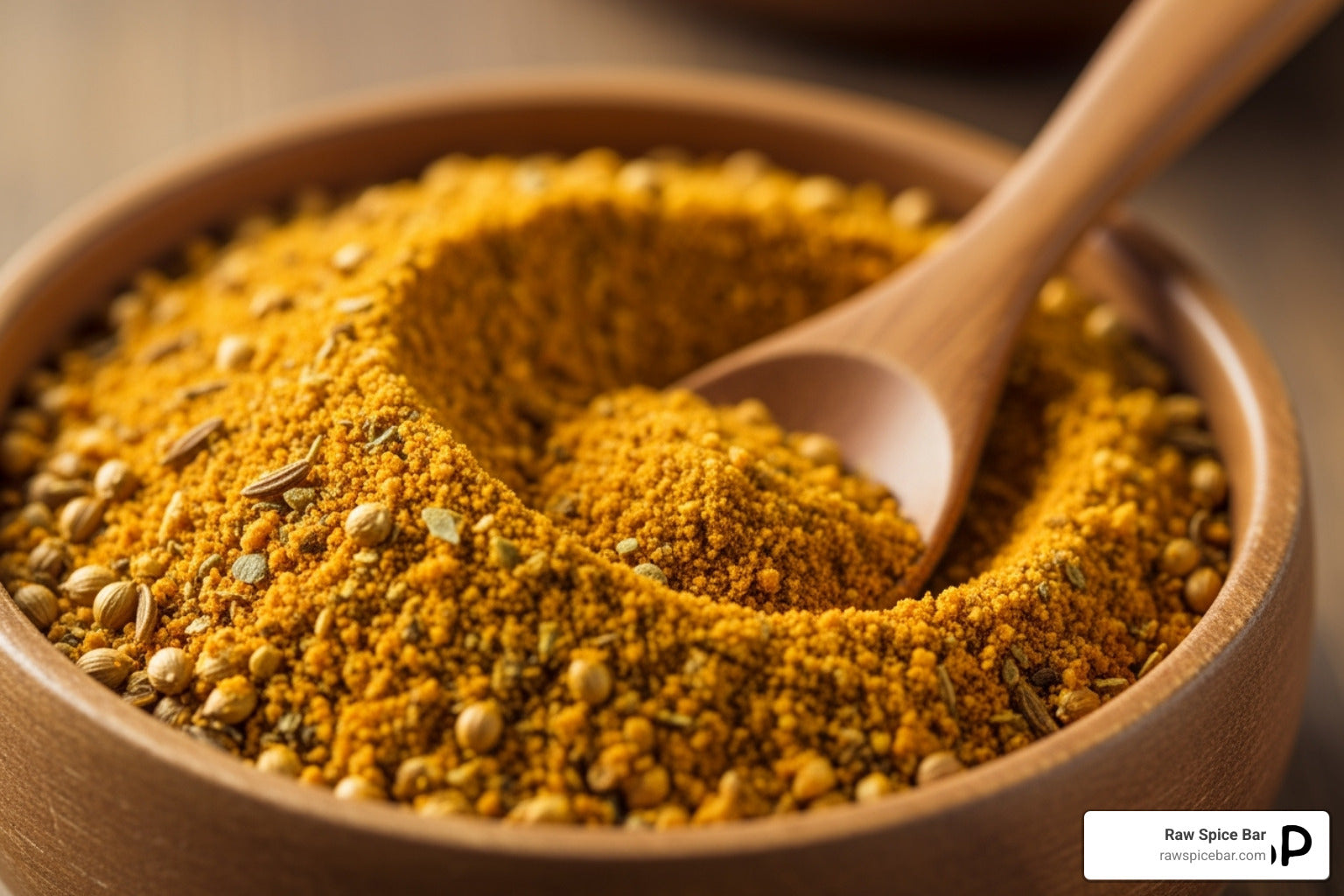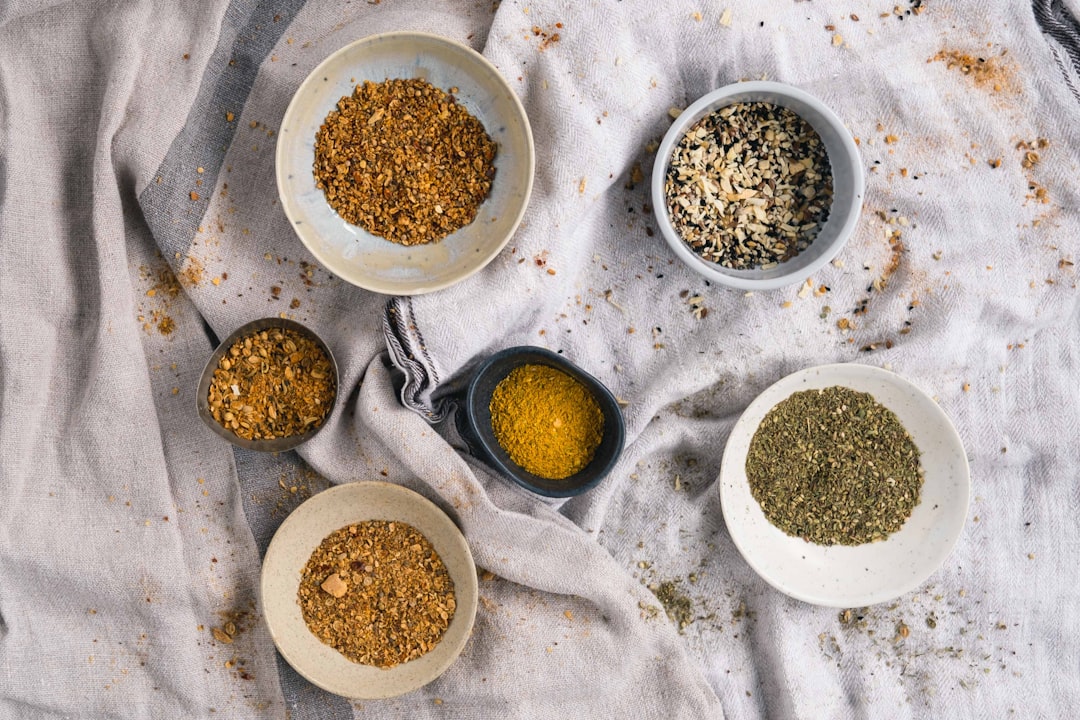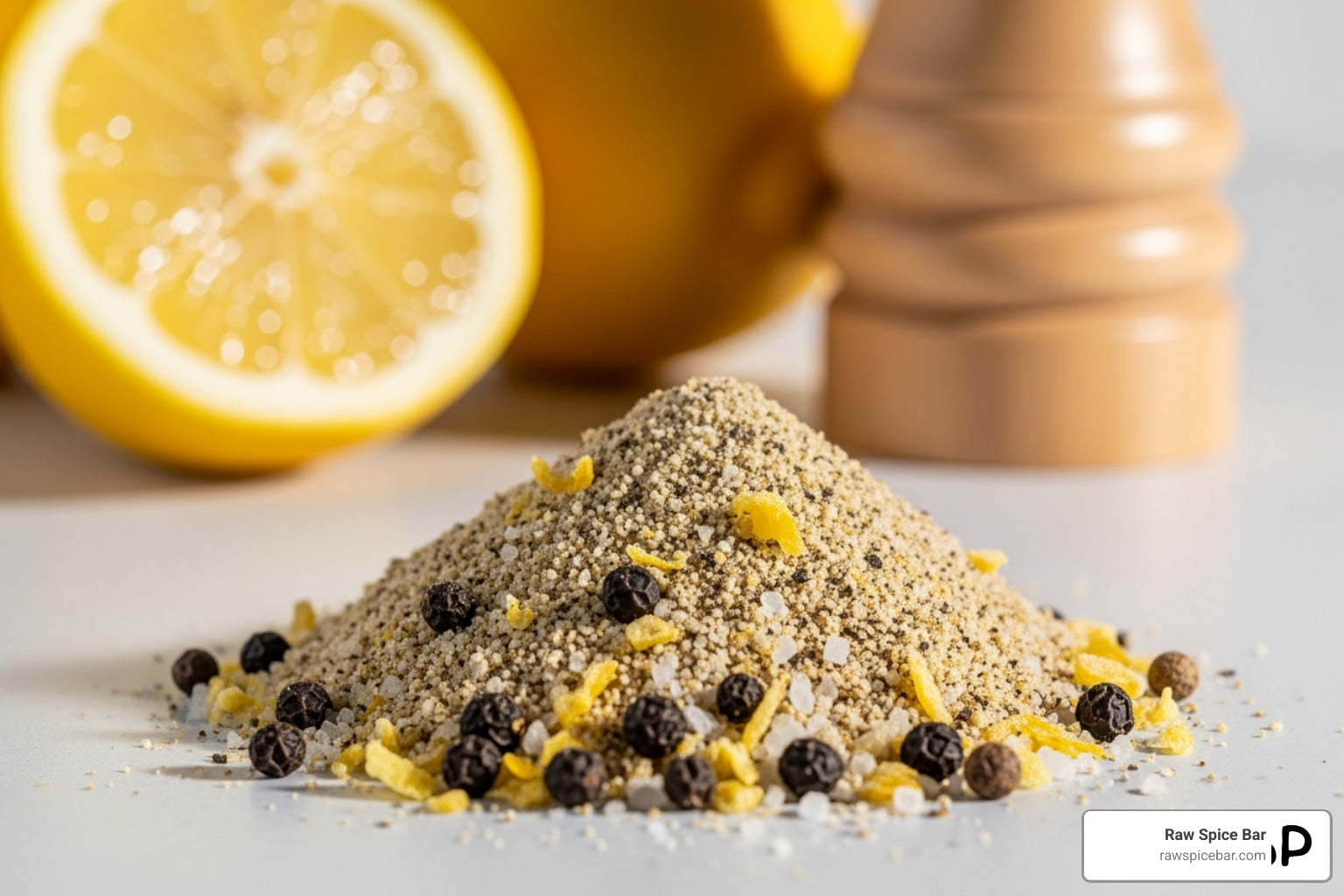Imagine transforming your cooking with vibrant, authentic seasonings from around the world.
How exciting would it be to bring the robust flavors of Creole, the earthy essence of Greek, or the warm spices of Indian cuisine straight into your dishes?
With the right blends, you can easily elevate your meals and make them stand out.
At Raw Spice Bar, we’re here to make that culinary adventure effortless. With our expertly crafted spice blends, you can explore flavors from across the globe without the hassle of tracking down hard-to-find ingredients. Whether it’s a zesty Creole seasoning or a fragrant Garam Masala, we bring these spices right to your door, ready to inspire your cooking.
With our global spice subscription, you’ll receive a variety of fresh, salt-free blends, each capturing the essence of its region. These flavors will breathe new life into your favorite recipes, making your meals exciting again.
In this blog, we’ll cover:
-
The rich history and cultural significance behind these authentic seasonings
-
How Creole, Greek, and Indian spices can completely transform your dishes
-
Tips on how to seamlessly incorporate these bold flavors into your everyday cooking
Ready to embark on this flavorful journey?
Let’s dive into the world of authentic seasonings and spice up your meals!
Overview of Authentic Seasonings
Authentic seasonings have roots that stretch across history and culture. From Creole to Indian, these blends bring unique flavors to dishes, transforming them into culinary experiences. You'll discover the rich history and cultural significance that make these seasonings valued worldwide.
History of Seasoning and Spices
Seasonings have been pivotal in human civilization, influencing trade routes and economies. They date back thousands of years, with evidence of trade between Asian and Middle Eastern civilizations. Spices like pepper, cinnamon, and cloves were as valuable as gold.
The desire for spices motivated explorers. The spice trade partly drove Columbus and Vasco da Gama's voyages. As explorers brought spices back to Europe, they became central to global cuisine development and influenced the culinary traditions you enjoy today.
Cultural Significance of Authentic Seasonings
Authentic seasonings reflect the cultural heritage and traditions of their origins.
A Creole blend, with its mix of sweet paprika and bay leaf, carries the spirit of New Orleans. Greek seasonings, with herbs like oregano and thyme, capture the essence of Mediterranean cuisine.
We offer seasoning blends that capture diverse culinary traditions. With our spice subscription, you can explore these global flavors in your kitchen. Each packet includes spice blends made from fresh, vibrant ingredients for deep flavors that excite your senses.
Discover how these seasonings can transform ordinary meals into exceptional dining experiences.
Creole Seasoning
Creole seasoning adds a unique, vibrant flavor to many dishes. It combines influences from various cultures, reflecting its rich history. This seasoning mix includes ingredients that create bold, robust flavors suitable for various culinary applications.
Origins of Creole Flavor
Creole seasoning has roots in New Orleans's cultural melting pot.
Influences from French, Spanish, African, and Native American cuisines have shaped its unique flavor profile. This blend developed over time, combining ingredients and traditions from these diverse cultures.
Creole cooking emerged in the 18th century with the arrival of settlers in Louisiana. They brought with them spices and culinary styles from Europe and Africa. Over time, these elements combined, creating a distinct Southern flavor that became synonymous with Creole cooking.
Key Ingredients in Creole Seasoning
Essential ingredients in Creole seasoning include paprika, garlic powder, onion powder, and cayenne pepper. These components provide the mix's deep, spicy taste. Other common inclusions are black pepper, oregano, thyme, and celery seed, each adding layers of flavor.
This variety of spices ensures a balance of heat and aroma. Cayenne pepper gives it a spicy kick, while herbs such as thyme and oregano add earthiness. Each ingredient plays a specific role, creating a well-rounded seasoning.
Culinary Applications of Creole Seasoning
Creole seasoning enhances dishes like gumbo, jambalaya, and etouffee.
It complements seafood, poultry, and even vegetables, providing a taste of New Orleans in various meals. Due to its bold flavor, this seasoning is a favorite for grilling and roasting.
For home cooks looking to expand their culinary repertoire, a spice blend offers an excellent way to experiment with Creole flavors. Our spice subscription allows you to receive fresh, authentic Creole seasoning that elevates your dishes with vibrant tastes inspired by Louisiana's rich culinary traditions.
Greek Seasoning
Greek seasoning is a blend that adds the fresh and aromatic tastes of the Mediterranean to your meals. It's perfect for enhancing simple dishes with its mix of herbs and spices.
Essence of Greek Cuisine
Greek food focuses on fresh ingredients and simple preparation.
It emphasizes aromatic and earthy flavors. Olive oil, lemons, and herbs are key to its distinct taste. This focus on freshness offers a vibrant and healthy eating experience. Greek seasoning captures this essence by combining classic herbs and spices stapled in many Mediterranean dishes.
Main Components of Greek Seasoning
Greek seasoning typically includes oregano, thyme, basil, and marjoram.
Lemon peel adds a citrusy brightness, and black peppercorns hint at spice. Sometimes, a touch of nutmeg and cinnamon is included for warmth. These ingredients are mixed to create a balanced flavor profile.
Each element in the blend complements others, making it versatile for various recipes.
Usage of Greek Seasoning in Recipes
Greek seasoning is ideal for giving your meals a Mediterranean flair.
You can use it in marinades for grilled meats like chicken or lamb. It's also great for making homemade gyro sauces and lemon dressings. Sprinkle it over potatoes before roasting, or mix it into olive oil for a delicious dipping sauce.
With spice blends, every dish becomes a flavorful experience. Subscribers receive recipe cards to explore new culinary ideas every month, encouraging creativity in the kitchen.
Indian Seasoning
Indian cuisine is renowned for its vibrant flavors, created through diverse spices and expertly crafted blends. Indian seasonings can transform any dish, bringing warmth and complexity to every bite.
Diversity in Indian Spice Blends
Indian spice blends vary widely across regions.
Each has unique combinations reflecting local ingredients and traditions.
-
In the north, you find garam masala, featuring a mix of coriander, cumin, and cinnamon.
-
Southern regions often use blends like sambar powder, which is made with spices such as curry leaves and lentils. These blends aren't just about heat; they contribute depth with aromas and subtle flavors, making Indian cuisine distinct and flavorful.
Our spice subscription helps you explore various Indian seasonings, ensuring a fun and delicious cooking experience.
Core Spices in Indian Cooking
Many spices form the backbone of Indian cooking.
Turmeric is essential for its color and earthy flavor, while cumin adds warmth. Coriander seeds lend notes of citrus and nuttiness, and mustard seeds provide a spicy kick. Fennel seeds, with their sweet licorice taste, often balance savory dishes.
These spices create layers of taste and aroma that define Indian dishes.
Techniques of Seasoning in Indian Cuisine
Seasoning techniques in Indian cooking bring out the best of each spice.
One common method is "tadka" or tempering, where whole spices are briefly fried in hot oil or ghee, enhancing their flavor before adding them to a dish. Another technique involves dry roasting, which intensifies the aroma of ground spices.
These methods help release essential oils from the spices, infusing your dishes with complex flavors.
Global Influence on Modern Cuisine
Modern cuisine thrives on diverse cultural influences, combining distinct flavors worldwide to create exciting and unique dishes. The impact of global flavors has transformed everyday meals into culinary adventures, connecting cultures through delicious, authentic tastes.
Fusion of Flavor Profiles
In modern cooking, fusion creates an exciting blend of different flavor profiles.
For instance, Creole seasonings mix African, French, and Spanish flavors, resulting in a spicy and aromatic taste. Greek seasonings combine herbs like oregano and thyme with the tang of lemon and olive oil, creating refreshing Mediterranean dishes.
India's rich array of spices, such as cumin, turmeric, and coriander, add warmth and complexity to any dish. Using such spice blends, you can easily experiment with different cuisines and make your meals more flavorful and exciting.
Authenticity in Contemporary Cooking
As you explore new culinary territories, maintaining authenticity is essential.
By staying true to traditional ingredients and techniques, you can pay homage to the origins of each dish. We provide healthy, salt-free spice blends that help keep your cooking genuine to its roots.
Subscribing to a global spice service brings fresh, authentic blends to your door, letting you cook with vibrant flavors year-round. When you incorporate these blends into your cooking, you're not just preparing a meal; you're embracing the culinary history of different cultures in your kitchen.
With easy-to-follow recipe cards, you can bring global authenticity to all your dishes, ensuring each meal is a delightful exploration of world cuisine.
Selecting High-Quality Seasonings
Choosing the best seasonings is crucial for adding authentic flavors to your dishes. High-quality spices offer richer tastes and aromas, transforming simple meals into exceptional culinary experiences.
Criteria for Premium Spices
When picking premium spices, freshness is key.
-
Look for spices that are vibrant in color and have a strong aroma. These qualities often indicate that the spices have been recently harvested and processed.
-
Avoid spices that seem dull or lack a strong smell, as they may have lost their potency.
-
Additionally, the texture of the spices can be a good indicator. Whole spices usually retain their flavor longer than ground ones. Grinding them fresh ensures the most intense taste.
-
Packaging also plays a role in maintaining a spice's quality. Opt for airtight containers to keep out moisture, which can diminish flavor.
Sourcing and Sustainability
The source of your seasonings affects both flavor and environmental impact.
Aim for spices that are ethically sourced. Ethical sourcing means that the spices are cultivated in ways that support the local environment and economy.
Look for information on where the spices come from and consider brands that prioritize sustainable practices. These practices might include using organic farming methods or supporting local farmers.
Storing and Preserving Flavors
Spices play a vital role in making dishes burst with flavor. To keep your spices fresh and flavorful, pay attention to how you store them. Proper storage helps maintain their potency and aromatic qualities, ensuring every meal is a delight.
Tips for Spice Storage
Keep your spices in a cool, dry place, away from sunlight and heat sources like the stove or microwave. Sunlight and warmth can cause the oils in spices to evaporate, dulling their flavor.
Use airtight containers, such as glass jars or tins, to protect spices from moisture and air. Moisture can lead to clumping and spoilage. Plastic bags are not ideal; they can let in air and cause your spices to lose their aroma.
Consider labeling each container with the date of purchase. This helps you track how long you’ve had them. While spices generally don't go bad in a way that makes you sick, they lose flavor over time.
For the best taste, aim to replace ground spices every 6-12 months. Whole spices last longer, often retaining flavor for up to 2 years.
Maximizing Freshness and Potency
To ensure freshness, try buying spices in small quantities. This way, you can enjoy their full flavor without having a big stash that lasts for years.
Grind whole spices as needed. Whole spices hold onto their oils better, which keeps them fresh longer. Use a spice grinder or mortar and pestle before adding them to your dish.
Another tip is to avoid storing spices above your stove, as the rising steam can introduce moisture. For the same reason, be cautious about keeping spices near your sink.
Creole and More: Blending Traditions
Creole seasoning is a wonderful combination of cultural influences that brings bold flavors. By incorporating spices from around the world, you can create innovative dishes that are anything but ordinary.
Innovative Recipes with Cross-Cultural Spices
Blending Creole with other cultural seasonings opens the door to exciting new culinary experiences.
Imagine using a Creole spice mix to elevate a Greek salad or giving Indian curries a spicy twist. These combinations highlight how spices can seamlessly bridge different culinary traditions.
At Raw Spice Bar, we make it easy to explore these possibilities. Our global spice subscription offers spice blends and recipe cards that guide you in creating diverse, flavorful dishes.
Each month, you'll receive fresh, authentic spices to experiment with in the kitchen. This approach helps you create vibrant meals that capture the essence of different cultures, offering a fun and educational cooking experience.
Balancing Flavor and Authenticity
It's essential to keep the flavors balanced when mixing spices from different traditions.
Too much of one spice can overpower the others, while too little might not make the desired impact. Start small and taste as you go to find the right mix.
With our carefully crafted blends, you can enjoy authentic flavors without the guesswork. Each blend is made with fresh ingredients and designed to showcase global tastes. This ensures that you get both authenticity and excitement in every dish, making your meals more than just food—they become an exploration of culture and taste.
Frequently Asked Questions
Have you ever found yourself wondering how to get the best out of your seasonings? Whether you're a seasoned home chef or just starting your culinary journey, the right spices can make all the difference. Here are some of the most frequently asked questions to help you get the most from your global spice blends and take your cooking to the next level.
Where can I find authentic Creole, Greek, and Indian seasonings?
Specialty spice providers like Raw Spice Bar offer authentic seasonings from different cuisines. We also offer a global spice subscription that delivers unique spice blends directly to your door.
How do Creole, Greek, and Indian seasonings differ in terms of ingredients and uses?
Creole seasonings often include cayenne, paprika, and garlic, while Greek seasonings feature oregano, rosemary, and thyme. Indian spice blends like garam masala are rich with cumin, coriander, and cardamom. Each is used to bring distinct flavors to dishes.
What are some recipes that use Creole, Greek, or Indian seasonings prominently?
Jambalaya is a classic dish that highlights Creole seasoning. Greek salad can be enhanced with Greek seasoning, while Indian curries benefit from traditional Indian spice blends.
Can you suggest some trusted brands for high-quality Creole seasoning?
Raw Spice Bar is known for their high-quality Creole spice blends. Our products are crafted with fresh ingredients for deep, authentic flavors in your cooking.
What are the essential spices to create a traditional Greek seasoning blend?
A traditional Greek seasoning blend typically includes oregano, rosemary, thyme, and garlic. These herbs and spices combine to create the signature Mediterranean flavor profile.
How can I distinguish between Creole and Cajun seasoning when cooking?
Creole seasoning often includes more herbs like thyme and oregano than Cajun seasoning, which is generally spicier and focuses on paprika, cayenne, and pepper.




